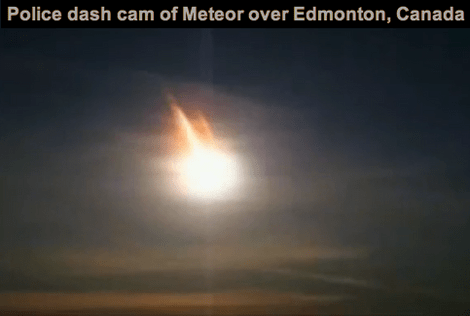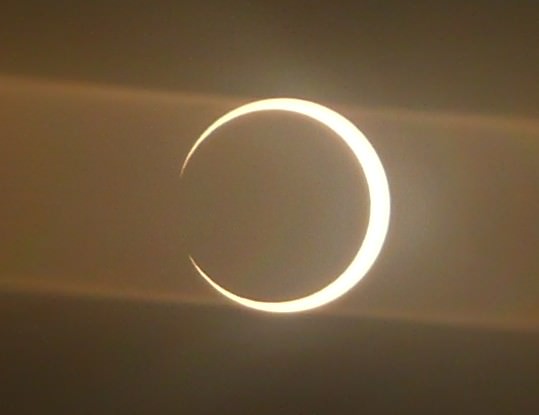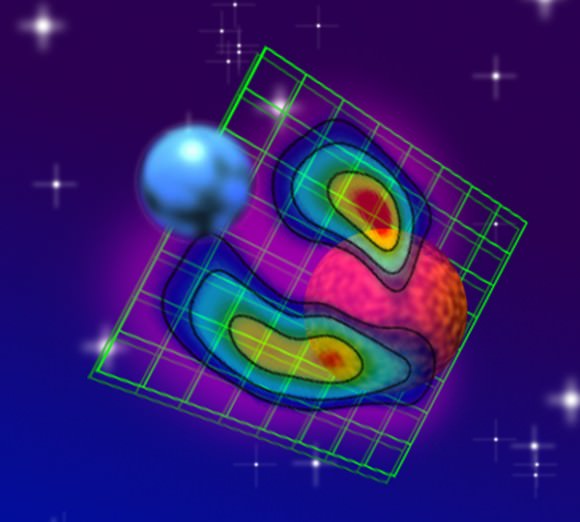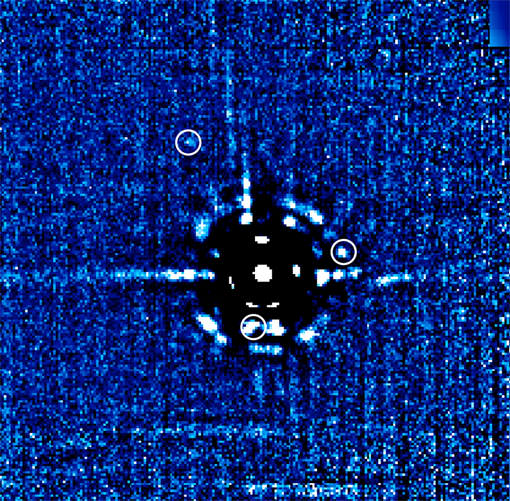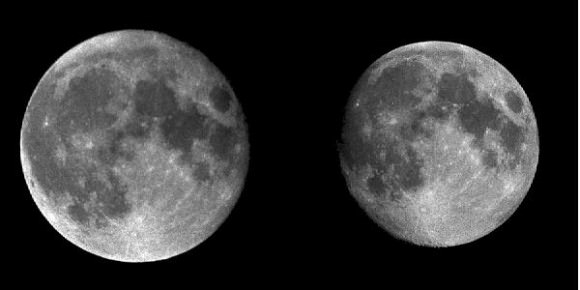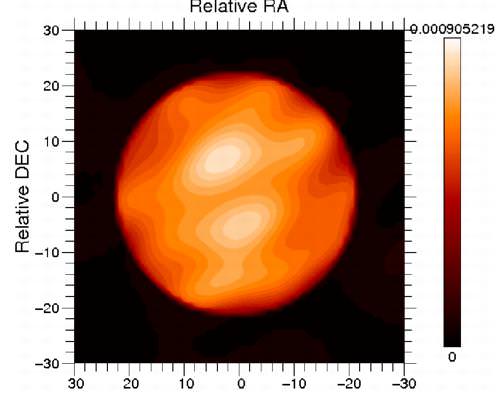The Coma Berenicid Meteor Shower Peaks
Awake during the wee hours of the morning? Try heading outdoors for awhile to watch for the "guess-timated" peak of the Coma Berenicid meteor shower on the morning of January 19. It might not be the most prolific meteor shower on record and this might not be the perfect peak, but this year's presence is making headlines! (...)
Read the rest of The Coma Berenicid Meteor Shower Peaks (778 words)
Annular Eclipse Photos, Videos From Earth and Space
Caption: Annular solar eclipse on January 15, 2009. Courtesy Daniel Fischer, "cosmos4u" on Twitter.
The first of two solar eclipses to occur in 2010 took place Friday, January 15. This was an annular eclipse, which means the Sun was not totally covered by the Moon, creating a "ring of fire." The eclipse was visible from a 300-km-wide track that passed over central Africa, across the Indian Ocean, over the southern tip of India and the northern end of Sri Lanka, and then across parts of Bangladesh and Myanmar. At the center of the track, the eclipse endured for 11 minutes and eight seconds, setting a record that won't be beaten until December 23, 3043. Weather cooperated in many regions, allowing good viewing conditions. Here are a few images and videos from Daniel Fischer, who was in Varkala, India, and another group who calls themselves Eclipse Hunt 2010 crew were in Jaffna, Sri Lanka. The image above is from Fischer, who said via Twitter that his travels to view the eclipse was a total success. "Deep blue sky, not a single cloud all day, photo plans worked."
(...)
Read the rest of Annular Eclipse Photos, Videos From Earth and Space (658 words)
If Phoenix Arises, Science could flow quickly
Caption: This mosaic assembled from Phoenix images shows the spacecraft's three landing legs and patches of water ice exposed by the landing thrusters. Splotches of Martian material on the landing leg strut at left could be liquid saline-water. Larger version on Spaceflightnow.com .Credit: Kenneth Kremer, Marco Di Lorenzo, NASA/JPL/UA/Max Planck Institute and Spaceflightnow.com.
If the miraculous happens and contact is unexpectedly re-established with NASA’s Phoenix Mars Lander, science could flow almost instantly if the ships vital operating systems are healthy. Indeed a science plan could be swiftly put in place after determining the condition of the lander, says Doug McCuiston, director of Mars Exploration at NASA Headquarters. McCuiston explained to me in an interview that the initial science would be “a surface change and atmospheric imaging campaign that could begin nearly immediately. In that instance, if the cameras are operable it is easy to begin an imaging campaign with real-time planning”.(...)
Read the rest of If Phoenix Arises, Science could flow quickly (1,312 words)
Astronomy Without A Telescope – Getting Orientated
We’ve all been there. You’ve met someone nice – but for some inexplicable reason, they don’t get astronomy. So how do you start gently introducing them to your life’s passion (about astronomy that is) without scaring them away?
(...)
Read the rest of Astronomy Without A Telescope – Getting Orientated (493 words)
NASA Science News for January 15, 2010
Last year, when NASA's IBEX (Interstellar Boundary Explorer) spacecraft discovered a giant ribbon at the edge of the solar system, researchers were mystified. They called it a "shocking result" and puzzled over its origin. Now the mystery may have been solved.
FULL STORY at
http://science.nasa.gov/headlines/y2010/15jan_ibex2.htm?list1035898
NASA Science News for January 14, 2010
NASA's next great observatory, the James Webb Space Telescope, is designed to study stars and galaxies. Astronomers are beginning to realize, however, that Webb will make a great planet hunter too.
FULL STORY at
http://science.nasa.gov/headlines/y2010/14jan_planetsafari.htm?list1035898
Giant Magnetic Loop Stretches Between Two Stars
Using a collection of radio telescopes, astronomers have found a giant magnetic loop stretched outward from one of the stars making up the famous binary star system Algol, located in the constellation Perseus. "This is the first time we've seen a feature like this in the magnetic field of any star other than the Sun," said William Peterson, of the University of Iowa.
(...)
Read the rest of Giant Magnetic Loop Stretches Between Two Stars (300 words)
First Direct Spectrum of an Exoplanet Orbiting a Sun-like Star
Astronomers have obtained the first direct spectrum – a “chemical fingerprint” – of a planet orbiting a distant, Sun-like star, providing direct data about the composition of the planet's atmosphere. An international team of researchers studied the planetary system around HR 8799 a bright, young star with 1.5 times the mass of our Sun, and focused on one of three planets orbiting the star. While the results were unusual and pose a challenge to current models of the exoplanet's atmosphere, the accomplishment represents a milestone in the search for life elsewhere in the Universe.
(...)
Read the rest of First Direct Spectrum of an Exoplanet Orbiting a Sun-like Star (488 words)
Measuring the Moon's Eccentricity at Home
Caption: View of the moon at perigee and apogee
As a teacher, I'm always on the lookout for labs with simple setups appropriate for students. My current favorite is finding the speed of light with chocolate.
In a new paper recently uploaded to arXiv, Kevin Krisciunas from Texas A&M describes a method for determining the orbital eccentricity of the moon with a surprisingly low error using nothing more than a meter stick, a piece of cardboard and a program meant for fitting curves to variable stars.
(...)
Read the rest of Measuring the Moon's Eccentricity at Home (494 words)
Unprecedented Images Show Betelgeuse Has Sunspots
Caption:The surface of Betelgeuse in near infrared at 1.64 micron in wavelength, obtained with the IOTA interferometer (Arizona). The image has been re-constructed with two different algorithms, which yield the same details, of 9 milliarcseconds (mas). The star diameter is about 45 milliarcseconds. Credit: Copyright 2010 Haubois / Perrin (LESIA, Observatoire de Paris)
An international team of astronomers has obtained an unprecedented image of the surface of the red supergiant Betelgeuse, in the constellation Orion. The image reveals the presence of two giant bright spots, which cover a large fraction of the surface. Their size is equivalent to the Earth-Sun distance. This observation provides the first strong and direct indication of the presence of the convection phenomenon, transport of heat by moving matter, in a star other than the Sun. This result provides a better understanding of the structure and evolution of supergiants.
(...)
Read the rest of Unprecedented Images Show Betelgeuse Has Sunspots (536 words)
Dark Energy Model Explains 'Hubble Sequence' of Galaxies
Caption: A figure illustrating the Hubble sequence. Image: Ville Koistinen
One look at a Hubble Deep Field image reveals that galaxies come in all sorts of shapes and sizes. But why? Astronomers have been at a loss to explain the diversity of galaxy shapes seen in the Universe. But now, two astronomers have tracked the evolution of galaxies over thirteen billion years from the early Universe to the present day, helping to clarify the "Hubble Sequence," a classification of galaxies developed by Edwin Hubble. Keys to their model include galaxy mergers and dark energy.
(...)
Read the rest of Dark Energy Model Explains 'Hubble Sequence' of Galaxies (519 words)
Time-Lapse Movie Shows Massive Stars Form Similarly to Smaller S
It has been difficult for astronomers to see how massive stars form, since these stars are rare, form quickly and tend to be enshrouded in dense, dusty material which obscures them from view. But astronomers using the Very Long Baseline Array (VLBA) radio telescope were able to take images of the wavelengths of light emitted by a massive young star located 1,350 light years away in the Orion constellation. The created a 'movie' from the data, which they say shows the first evidence that young massive stars form from an accretion disk, just as smaller stars form.
(...)
Read the rest of Time-Lapse Movie Shows Massive Stars Form Similarly to Smaller Stars (464 words)
Vyugovey – The Real "Ice In Space"
Ain't no doubt about it… Space is cool! And this year Russian space exploration is not only cool – but ice cold. This year’s International Festival of Snow, Ice and Light sculptures “Vyugovey” will take place in Moscow from December 25 to February 28 in the Memorial Museum of Space Exploration {ark on Prospekt Mira, and is devoted to the 50th anniversary of Russian space exploration. (...)
Read the rest of Vyugovey – The Real "Ice In Space" (298 words)
STS-130 Shuttle flight facing delay due to Payload technical gli
Caption: Overhead view of Tranquility & Cupola modules inside the Space Station Processing Facility at Kennedy Space Center on Jan 8, 2010. Tranquility will be attached to ISS by STS 130 astronaut crew. Credit: Ken Kremer
(Editor's Note: Ken Kremer is in Florida for Universe Today covering the pre-launch activities of Endeavour.)
The launch of Shuttle Endeavour on the STS 130 flight now faces a potential delay due to technical problems with the external ammonia connecting lines which are designed to provide critical cooling capability to the new Tranquility module. Tranquility is a pressurized module being brought aloft as payload in the cargo bay of Endeavour on the STS 130 mission. Launch of Endeavour is currently set for 4:39 AM on Feb. 7.
(...)
Read the rest of STS-130 Shuttle flight facing delay due to Payload technical glitch (686 words)
More Saturn System Beauty from Cassini
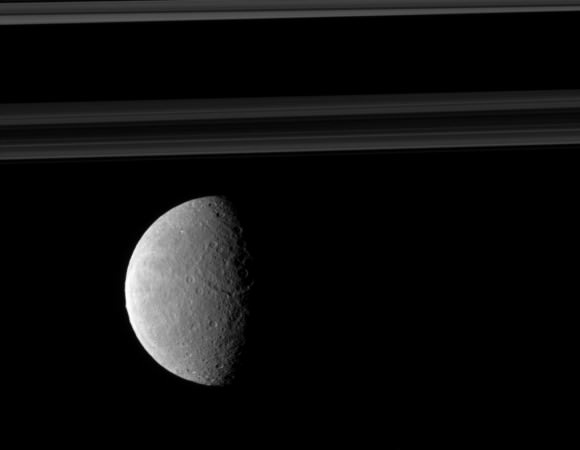
Caption: Cassini captures Rhea and Saturn's rings. Credit: NASA/JPL/Space Science Institute
The stunning images just keep coming from Cassini. Here's a collection of three recent images. Above, Saturn's moon Rhea teams up with the planet's rings, creating an image that could only come from the Saturn system. Taken on Nov. 4, 2009, Rhea's trailing hemisphere shows off its wispy terrain. The view was acquired at a distance of approximately 762,000 kilometers (473,000 miles) from Rhea, with the rings farther away, off in the distance.
(...)
Read the rest of More Saturn System Beauty from Cassini (243 words)
